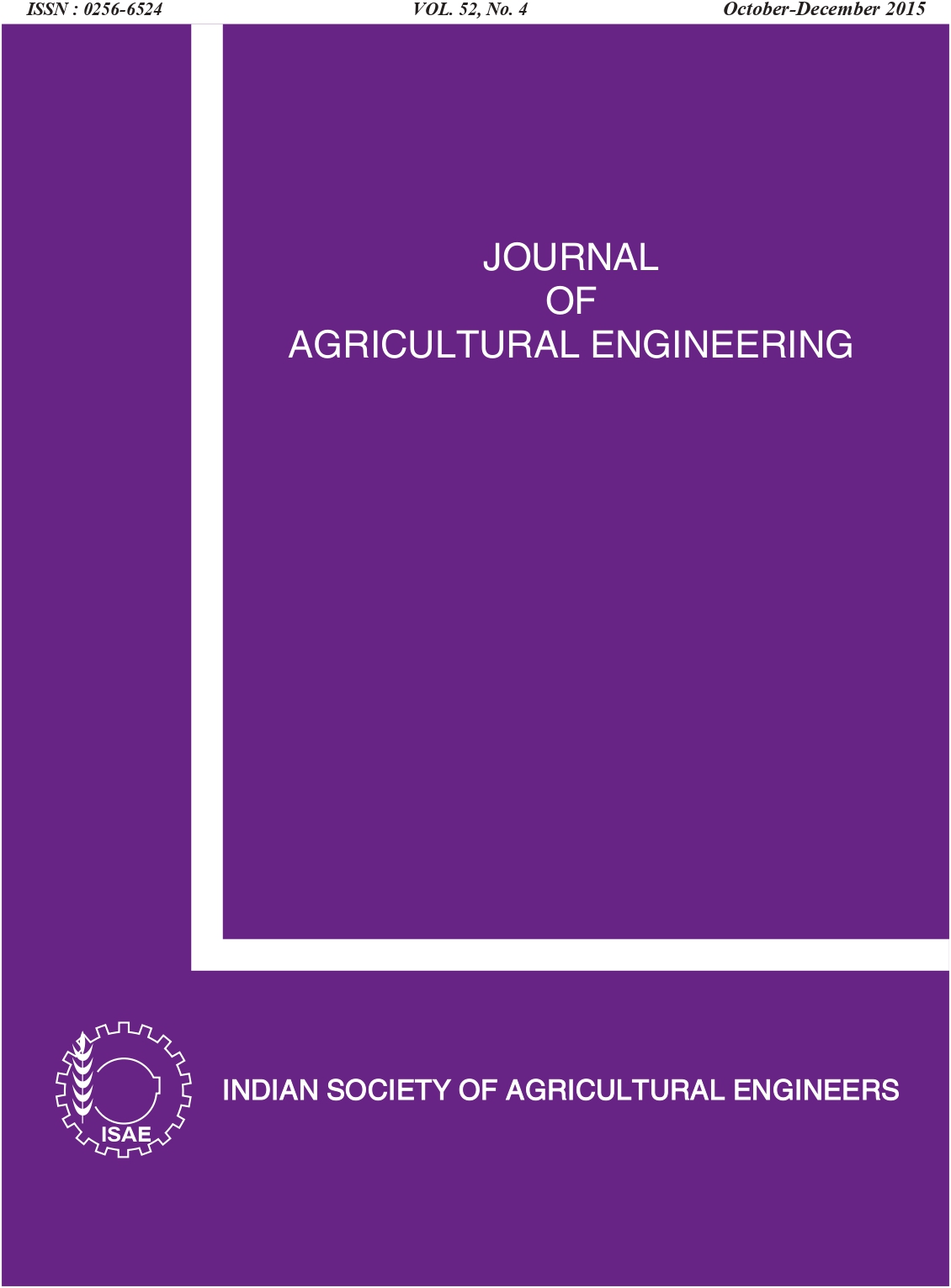Assessment of Reservoir Sedimentation in Arid Region Watershed of Gujarat
DOI:
https://doi.org/10.52151/jae2015524.1590Keywords:
Arid region, depth-capacity curve, Kriging, reservoir, reservoir sedimentation, topographical surveyAbstract
The study aimed at sedimentation assessment in a reservoir, for the first time, in an arid region watershed located in Kukma village of Kachchh, Gujarat by performing aerial topographical survey. The topographical database was subjected to SURFER software to generate grid, contour map and three-dimensional digital model of the reservoir by interpolating reduced levels spatially using kriging technique. Storage volumes were computed for entire depth of the reservoir at 10 mm intervals using trapezoidal formula. The storage volume data were utilized to develop depth-capacity curve, which was fitted with logarithmic, power, and exponential empirical regression models; and the best-fit model was selected by applying correlation coefficient (R), coefficient of determination (R2 ), root mean square (RMSE), modified Nash-Sutcliffe efficiency (MNSE) and modified index of agreement (MIA) goodness-offit criterion. Contour map of the reservoir revealed the maximum depth of 2.85 m corresponding to full storage capacity of 24879 m3 . The three-dimensional view closely matched with the real outlook, which confirmed accuracy of the survey and data analysis. The depth-capacity curve was utilized to determine rainwater storage during years 2012 and 2013 as 925 and 24879 m3 , respectively, in response to 79.1 and 291.9 mm of rainfall, respectively. This finding suggested that reduction in monsoon rainfall caused significant reduction in the rainwater storage. The power regression model was considered as the best-fit in this study due to the lowest RMSE (293 m3 ), and highest R (0.98) and R2 (0.93) values. The values of MNSE (0.60) and MIA (0.83) further supported the selection of the best-fit model. It was revealed that capacity of the reservoir reduced by 4305.5 m3 (14.75%) over a period of 12 years due to sedimentation at average annual rate of 358.8 m3 . Finally, it is emphasized that there is need for planning and implementation of appropriate soil conservation measures within the reservoir catchment.
References
ICAR - Central Arid Zone Research Institute, Regional Research Station, Kukma, Bhuj – 370 105, Gujarat
ICAR - Central Arid Zone Research Institute, Regional Research Station, Kukma, Bhuj – 370 105, Gujarat
Krishi Vigyan Kendra, ICAR - CAZRI, Bhuj – 370 105, Gujarat
Batuca D G; Jordaan J M. 2000. Silting and Desilting of Reservoirs. A.A. Balkema, Rotterdam, the Netherlands, pp: 353.
DWDU. 2010. Detailed Project Report. Integrated Watershed Development Programme (IWMP-8). District Watershed Development Unit (DWDU), Bhuj, Kutch, Gujarat.
Ferrari R; Collins K. 2006. Reservoir Survey and Data Analysis. In: Anonymous (editor), Erosion and Sedimentation Manual, Chapter 9, United States Department of the Interior, Bureau of Reclamation, Colorado, 9-1 to 9-65.
ILWIS. 2001. Integrated Land and Water Information System, 3.2 Academic, User’s Guide. International Institute for Aerospace Survey and Earth Sciences (ITC), The Netherlands, 428-456.
Jain S K; Singh P; Seth S M. 2002. Assessment of sedimentation in Bhakra Reservoir in the western Himalayan region using remotely sensed data. Hydrolog Sci. J., 47(2), 203-212.
Journal A G; Huijbregts C J. 1978. Mining Geostatistics. Academic Press, London.
Kar A; Singh N. 2003. Desertification in arid Kachchh Region of Gujarat: present status and responsible factors. In: P. Narain, S. Kathju, A. Kar, M.P. Singh, and P. Kumar (Ed.), Human impact on Desert Environment, Scientific Publishers, Arid Zone Research Association of India, Jodhpur.
Kitanidis P K. 1997. Introduction to Geostatistics: Applications in Hydrogeology. Cambridge University Press, New York, pp: 249.
Kothyari U C. 1996. Erosion and Sedimentation Problems in India. In: Walling D.E. and Webb, D.W. (Ed.), Erosion and Sediment Yield: Global and Regional Perspectives. Proceedings of the Exeter Symposium, IAHS Publication No. 236, 531-540.
Legates D R; McCabe Jr G J. 1999. Evaluating the use of “goodness-of-fit” measures in hydrologic and hydroclimatic model validation. Water Resour. Res., 35, 233-241.
Lin S S. 1997. Strategies for Management of Reservoir Sedimentation. Virginia Dam Safety Program, Richmond, Virginia.
Machiwal D; Dayal D. 2011. Need of soil and water conservation measures in Kukma watershed of Kachchh district, Gujarat. In: Proceedings of the National Symposium on Resource Utilization through Integrated Farming System and Biodiversity Conservation in Drylands organized by CAZRI, Jodhpur, Dec. 20-22.
Machiwal D; Dayal D. 2013. Factors responsible for restricted storage and short availability of harvested rainwater under steep topography and arid climate. In: Proceedings of the International Symposium on Bio-Energy: Challenges and Opportunities organized by Indian Society of Agricultural Engineers, Hyderabad, Jan. 28-30.
Machiwal D; Kumar S; Dayal D. 2015. Characterizing rainfall of hot arid region by using time series modelling and sustainability approaches: a case study from Gujarat, India. Theoretical and Applied Climatology, DOI 10.1007/s00704-015-1435-9.
Morris G L. 1995. Reservoir sedimentation and sustainable development in India. In: Proceedings of Sixth International Symposium on River Sedimentation, New Delhi, India, 57-61.
Moore D S. 1991. Statistics: Concepts and Controversies. 3rd edition, W.H. Freeman, New York, pp: 439.
Pande V C; Kurothe R S; Sena D R; Kumar G. 2014. Cost of siltation in Sardar Sarovar reservoir: implications for catchment treatment. Current Sci., 106(1), 35-39.
Prusty B A K. 2009. Need for conservation of wetlands in arid Kachchh region. Current Sci., 97(6), 745-746.
Randle T J; Yang C T; Daraio J. 2006. Erosion and Reservoir Sedimentation. In: Anonymous (Ed.), Erosion and Sedimentation Manual, Chapter 2, United States Department of the Interior, Bureau of Reclamation, Colorado, 2-1 to 2-94.
Singh S; Kar A. 1996. Integrated Natural and Human Resources Appraisal for Sustainable Development of Kachchh District. Report of Central Arid Zone Research Institute, Jodhpur, pp: 165.
Sumi T; Hirose T. 2009. Accumulation of sediment in reservoirs. In: Takahasi, Y. (Ed.), Water Storage, Transport and Distribution, UNESCO-IHE and EOLSS Publishers Co. Ltd., 224-252.
SURFER. 2003. Surface Mapping System. Surfer version 8.03, Golden Software, Inc., Colorado, www.goldensoftware.com.
Willmott C J; Ackleson S G; Davis R E; Feddema J J; Klink K M; Legates D R; O’Donnell J; Rowe C M. 1985. Statistics for the evaluation and comparison of models. J. Geographical Res., 90, 8995-9005.














